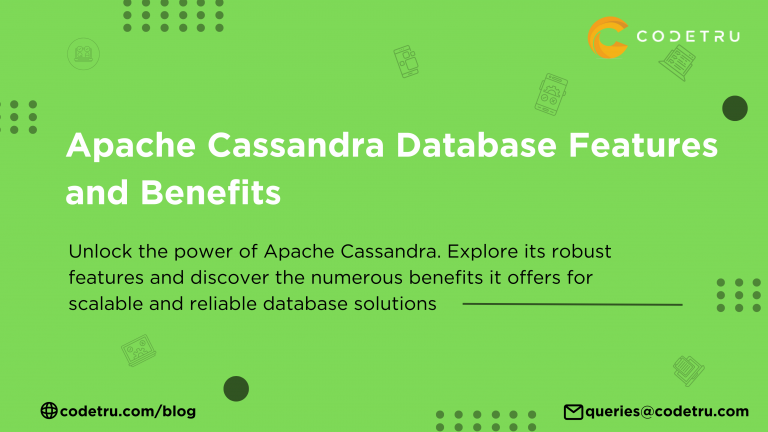Cassandra is an extremely modular, high-execution distributed database developed to address considerable amounts of data across multiple commodity servers, furnishing high availability with no single issue of oversight. Initially, Cassandra is a distributed NoSQL database created for Facebook to power the inbox search feature and was later released as an open-source project in July 2008.
In 2009, Cassandra became part of the Apache Incubator and Since early 2010, it has remained as a commendable Apache project. Currently, it’s a key part of the Apache Software Foundation and can be employed by anyone yearning to leverage it. Due to its robust underlying architecture and remarkable technical features, Cassandra has taken all the accolades and become so esteemed. It can act as both a real-time operational data store and a read-intensive database for online transactional applications and large-scale business intelligence systems respectively.
Cassandra stands ahead of most database systems in terms of the technical facilitations it renders over other systems. The capability to manage a lofty amount of data makes it particularly fruitful for major establishments. As a consequence, it’s presently being employed by many gigantic enterprises like Apple, Facebook, Instagram, Uber, Spotify, Twitter, Cisco, Rackspace, eBay, and Netflix.
Remarkable Features of Cassandra

- Withstanding the fact that every node of Cassandra is capable of executing read and write operations, it gets effortless to replicate data across hybrid cloud settings and landscapes. With Cassandra, the user is automatically redirected to the closest active node if a node fails. Surprisingly, they won’t even witness that a node has been struck offline because the applications will be working as designed even in the instance of delinquency. Because of that, applications are always accessible and so the data will never vanish. To your surprise, the built-in repair services feature will sort the issues instantly as they occur without demanding any external assistance(manual) which results in relentless productivity.
- The preponderance of conventional databases portrays a primary/secondary architecture where the read and write operations are executed by a single primary replica and secondary replicas will only be able to perform write operations. Well Surprisingly, this architecture also has drawbacks like an expanded interruption, towering costs, and inferior ease of access at scale. With Cassandra, no single node is accountable for replicating data across a cluster. Rather, every node owns the ability to execute all read and write operations and this tendency will surely uplift the enactment and append resiliency to the database.
- The New-age software development establishments have irresistibly pushed themselves forward to espouse open-source technologies, starting with the Linux operating system and advancing to infrastructure for handling data. Considering the factors like affordability and extensibility, Open-source technologies are attractive. On top of that, the flexibility to sidestep vendor lock-in. Intriguingly, the enterprises adopting open source report a notable pace of innovation and faster embracement.
- Since Cassandra Query Language and SQL are quite identical in terms of multiple perspectives. As most developers are acquainted with a decent amount of knowledge of SQL, it doesn’t take much time for them to adapt to CQL.
- In Conventional settings, it gives a hard time measuring applications since the process is extremely time-consuming and expensive. Hence, organizations fulfill this requirement by scaling vertically with highly expensive machines. In this scenario, Cassandra allows you the ease to scale horizontally by annexing more nodes to the cluster.
Who Can Employ Cassandra Database?
Cassandra will be a great solution for your business if you need to keep and handle huge amounts of data through multiple servers. Also, Cassandra will be an ideal database to integrate and employ if you are scared that your data might get lost and also for those who can’t maintain their database due to the breakdown of a single server. In addition to that, its ability to get easily utilized and scaled makes it perfect for enterprises looking forward to developing consistently. Cassandra can efficiently manage an extensive amount of data and simultaneous users which allows big organizations to hold immense data within a redistributed system. Yet, despite the decentralization, it even permits users to retain control and access to data.
Some Popular Tools Integrated with Cassandra

Biggies Using Cassandra

Cassandra Pros
- The persistent availability of data is one captivating attribute of the Cassandra database.
- Cassandra database is highly budget-friendly and demands very low maintenance.
- The execution rate of the platform is extensively remarkable and has a low tolerance.
- For organizations having applications with serious issues with execution in their production systems, the Cassandra database will be ideal.
- Cassandra databases can efficiently manage huge datasets and it renders extensive flexibility.
- The setup and maintenance of the Cassandra database are effortless from every perspective.
- With Cassandra, applications can write any node always and everywhere.
- It has involuntary workload administration and data balancing throughout the nodes.
Cassandra Cons
- There’s so much room left for development when it comes to transferring data from Cassandra to any affinitive database platform.
- Aggregates are not supported by Cassandra.
- Cassandra is not appropriate for transactional data.
- Cassandra neither supports broad analysis on storage, nor does it support sum, group, join, max, min, and any other functions that developers wish to employ to analyze data while querying.
5-Top-FAQs About Apache Cassandra Database
1. What is Apache Cassandra and how does it work?
Apache Cassandra is a distributed NoSQL database designed to handle large amounts of data across multiple servers to ensure high availability and fault tolerance. It works by partitioning data across nodes in a cluster, a each node can handle read and write operations. This decentralized architecture allows for seamless data replication and high performance, making it ideal for applications that require scalability and reliability
2. What are the main features of Apache Cassandra?
Cassandra offers many outstanding features, e.g.
a. Decentralized architecture without a single failure.
b. High scalability for processing big data.
c. Continuous availability with automatic data replication and failover.
d. Flexible system while supporting dynamic data structures.
e. Seamless integration of other open source tools and platforms.
3. How does Apache Cassandra ensure data availability and fault tolerance?
Cassandra ensures data availability and fault tolerance through its distributed architecture and replication strategy. Data is automatically processed on multiple nodes, and if a node fails, the system redirects requests to the nearest active node without interruption. This redundancy assures that applications remain accessible and data is protected from node failures.
4. What are the advantages of using Apache Cassandra for big data applications?
The advantages of using Cassandra for big data applications include:
a. High performance and low latency for read and write operations.
b. Horizontal scalability by adding more nodes to the cluster.
c. Cost-effective and low-maintenance due to open-source nature.
d. Support for high-throughput and concurrent user access.
e. Suitable for handling vast amounts of unstructured data across distributed systems.
5. What are some limitations of Apache Cassandra?
While Cassandra is powerful, it has certain limitations:
a. It doesn’t support joins, aggregates, or advanced querying functions natively.
b. Data migration to other databases can be complex.
c. Not ideal for transactional data requiring ACID compliance.
d. Limited built-in support for analytics and complex queries.
e. Requires careful planning and management to ensure optimal performance and data consistency.







